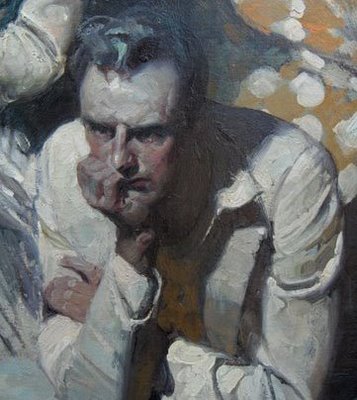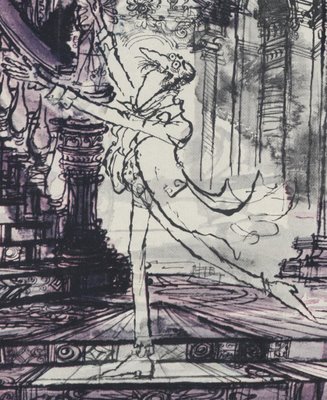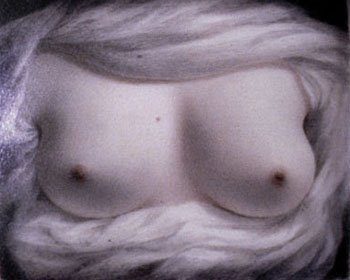ART AND COMPUTERS: THE IMPORTANCE OF AN "OBJECT"
The great illustrator Dean Cornwell applied oil paint like he was buttering a croissant.

I see this painting every day, and the pleasure I take from it is both visual and tactile. Cornwell's artistry is revealed at the exact place where his imagination interacts with the physical universe-- the stretched canvas that first yields and then springs to the touch, the sable brushes that spread, flex and taper as they sculpt the colors. I know this artist better for the sensuous experience of running my fingertips lightly across this painting.
As another example, Ronald Searle dips his pen in his DNA. He scuffs, scratches and scribbles on paper with ink, water and color to create an object which reveals his identity more than any fingerprint ever could.

I am sure that Searle could have increased the efficiency of his output by using the photoshop deflavorizing machine to erase mistakes (and to miss out on happy accidents). I'm not sure the result would be quite as personal.
My third example, a painting which I wrote about recently, has a different kind of physical significance. It is smooth and polished, with a surface that is visually not much different from a digital image.

Its significance stems instead from the way the artist invested a small piece of ivory with enormous emotional importance. With each of a thousand tiny brush strokes, she probably wondered whether she was doing the right thing. With a thousand and one alternate brush strokes, she was probably exhilarated by the prospect of baring herself to her secret friend. It matters that there was a luminous object rather than a jpeg for her friend to clutch and hold close.
These examples show that a physical object can reveal additional qualities and add a different layer of meaning to art.
Art that exists only as database of electromagnetic pulses can be just as beautiful as physical art, but I think we reserve a special sympathy for art that shares the mortality of physical things. Computer art is not made of perishable substance, and for that reason will always be a little more distant from the core of human concerns. As Thomas Mann wrote:
Love is our sympathy with organic life, the touchingly lustful embrace of what is destined to decay.In this regard, computer art (which never erodes or crumbles and can be perfectly replicated endlessly) leaves us behind.
None of this means that computer art isn't superior for some purposes. I have been gratified by the comments from those of you who are also trying to make sense of this area. I concur with those of you, such as Szy or L.A. Stern, who appreciate the importance of an art object just as I agree with those of you like Stefan, John and Insomniac who see a great future for computer art. In the end, I am with those who say that the greatest potential for computer art is where it is not trying to mimic traditional media. I plan to spend a little more time exploring this neighborhood but before leaving "the importance of an object," I thought I'd offer you one last quote from my guy Walt Whitman.
His poem, Whoever You Are Holding Me Now in Hand speaks of the importance to his poems of a physical touch:
[I]n libraries I lie as one dumb, a gawk, or unborn, or dead,
But just possibly with you on a high hill— first watching lest any person, for miles around, approach unawares,
Or possibly with you sailing at sea, or on the beach of the sea, or some quiet island,
Here to put your lips upon mine I permit you....
Or, if you will, thrusting me beneath your clothing,
Where I may feel the throbs of your heart....
For thus, merely touching you, is enough— is best.


